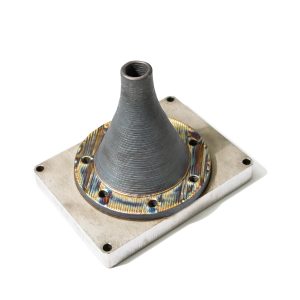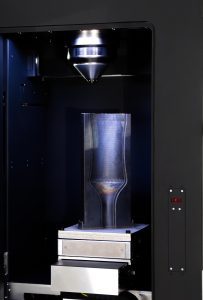While metal additive manufacturing is gaining traction, its wide-scale application will be slow as long as it’s considered a niche technology. Stainless Steel World talked to Lukas Hoppe, R&D Director at Meltio, about new technology designed to bring metal AM into the world of industrial production.
By Joanne McIntyre, Stainless Steel World
Lukas began by explaining that manufacturing faces challenges globally, from long lead times and stock-keeping costs caused by long and fragile supply chains to an ever-growing pressure to lower costs and reduce emissions.
“The vast majority of metal additively manufactured (AM) parts require post-processing in the machine shop. As our ambition is to push the large-scale adoption of metal AM, we consider the modern machine shop to be the ideal point of entry. Therefore we set out to develop new technology by imagining what the perfect AM printer for the machine shop would look like.”

Tackling cost, time and supply
The company’s new wire-laser metal 3D printer Meltio M600 is designed to manufacture and repair great volume metal parts with a large range of materials including aluminum, copper, titanium, stainless steel, nickel, invar, and others.
“Metal AM has huge potential to address these issues as it helps reduce lead times and manufacturing dependencies by printing parts in-house. This reduces warehouse inventory as raw material is transformed into the final part on demand, and reduces costs by applying material only where it is needed,” continues Lukas.
The advantages multiply for reflective materials, where near-infrared lasers lead to unsatisfactory results. By using Blue Laser technology combined with a fully inert workspace, the Meltio M600 can process an extensive range of materials efficiently while producing parts with exceptional properties.
“Unfortunately, metal AM has yet to realize its full potential; we still see it mostly applied to very high-value applications. Our technology improves on the state-of-the-art in several significant ways,” continues Lukas.
Practical application
 The Spanish cement company Cementos La Cruz has increased its productivity and efficiency by manufacturing a new stainless steel nozzle to manufacture more sustainable cement parts. Cementos La Cruz focuses on the development of low-carbon footprint cementitious materials to achieve sustainable construction. Its commitment to innovation focuses on the use of a circular economy and the development of technologies such as AM concrete solutions for construction.
The Spanish cement company Cementos La Cruz has increased its productivity and efficiency by manufacturing a new stainless steel nozzle to manufacture more sustainable cement parts. Cementos La Cruz focuses on the development of low-carbon footprint cementitious materials to achieve sustainable construction. Its commitment to innovation focuses on the use of a circular economy and the development of technologies such as AM concrete solutions for construction.
As the AM concrete process requires a high level of control over the material flow, the nozzle plays a critical role in the quality of the layers. Wire laser metal AM was used to produce a stainless nozzle which couldn’t be made using traditional manufacturing methods.
- The Blue Laser deposition head increases printing speed while reducing energy consumption due to increased absorption of the short wavelength light compared to most industrial lasers, which emit near-infrared light.
- The welding wire feedstock is cheaper, safer to handle and avoids contamination of CNC Machines compared to powder.
- Produces high-quality components with material properties comparable to conventionally manufactured parts.
- Designed to easily interface with CNC machines, it features a built-in 3-axis touch probe and supports various types of work-holding solutions. This means you can add features to or repair existing parts.
- Highly autonomous so operator interaction is minimal.
Wire laser metal AM
To make this new tool for machine shop use a reality, the M600 is the first Industrial wire-laser metal 3D printer to incorporate a Blue Laser deposition head. These lasers improve energy absorption and printing efficiency across the metal spectrum and open up new material possibilities while reducing the carbon footprint for production.
The company’s engineers also improved the energy distribution and wire guidance. The deposition head is aligned at the factory and is not operator-adjustable to ensure consistent output and reduced maintenance. Lastly, improved sensor solutions in the head for monitoring the printing process improve reliability.
Re-designed from scratch
 The goal of Meltio’s engineers was to design a system that fits into any machine shop and works alongside CNC machines, creating value by reducing material waste and lead times while increasing manufacturing flexibility. The system works like a machine tool, designed for lights-out manufacturing, and allows operators to complete complex print jobs with minimal time investment.
The goal of Meltio’s engineers was to design a system that fits into any machine shop and works alongside CNC machines, creating value by reducing material waste and lead times while increasing manufacturing flexibility. The system works like a machine tool, designed for lights-out manufacturing, and allows operators to complete complex print jobs with minimal time investment.
Lukas continues: “The M600 for us was really the next logical step on our continuous journey towards mass adoption of Wire-Laser DED. We began work in earnest in 2019 when we started to leave the prototyping space with the launch of the Meltio M450. After learning from and improving the technology for three years, the time was finally ripe for us to work on the next system. Our goal was to strike the right balance between machine size, cost, and productivity. To achieve this, we developed every single part of the machine from scratch, based on the learnings of having manufactured and installed over 300 Laser DED machines.”
About this Tech Article
This tech article appeared in Stainless Steel World, August 2024 magazine. To read many more articles like these on an (almost) monthly basis, subscribe to our magazine (available in print and digital format) – SUBSCRIPTIONS TO OUR DIGITAL VERSION ARE NOW FREE.
Every week we share a new Featured Story with our Stainless Steel community. Join us and let’s share your Featured Story on Stainless Steel World online and in print.

